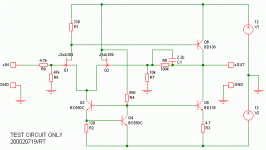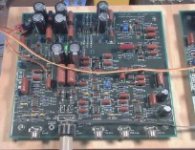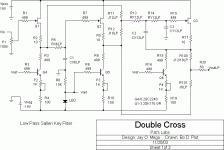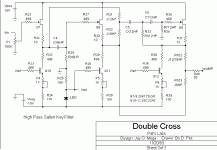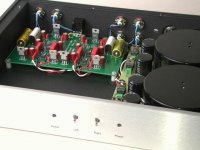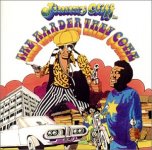Ain't mountain high enough.....
"To someone who's just starting out, the question of Q could be an entire thread on its own."
You are trying to reinvent the wheel......
The topology for the Sallen Key filter is extremely well documented for anybody that wants to read it. If people will go read the links in this thread they will find this out. Mr. Pass's monumental achievement is to make all this modular and adjustable for the non techo-nerd user. Hehas written a novel in how to use the crossover in the excellent manual, a manual so explicit that you could damn near reverse engineer the design. The slopes for the different Qs would allow someone to figure out the Qs needed in a hour of Spice simulation. This is not a molehill but it surely ain't no mountain.
The links again for something to read before Grey Day:
http://www.borbelyaudio.com/xover.pdf
http://www.passlabs.com/pdf/XVR1MAN1.PDF
http://www.t-linespeakers.org/tech/...Sallen-Key.html
I believe the Q calculation are fast and loose in this reference and you may want to look at the following for exact calculations. Don't be put off by the derivations of the equations. The actual caculation for the values of Fc and Q are very simple.
http://www.web-ee.com/primers/files/Sallen_Key.pdf
For a Spice text file (and most free student Spice programs should handle a GIU version of a circut this simple):
http://www.ecircuitcenter.com/Circu...1/opsalkey1.htm
A good collection of filter design links:
http://www.circuitsage.com/filter.html
Filter pro from TI( One that I like to use that is pretty simple and has good documentation):
http://focus.ti.com/analog/docs/sam...vigationId=9742
Since you find it such a mountain to climb, why not call it the Everest? After all the rest of use are wondering if we will ever see it......
See you at the top,
Fred
"To someone who's just starting out, the question of Q could be an entire thread on its own."
You are trying to reinvent the wheel......
The topology for the Sallen Key filter is extremely well documented for anybody that wants to read it. If people will go read the links in this thread they will find this out. Mr. Pass's monumental achievement is to make all this modular and adjustable for the non techo-nerd user. Hehas written a novel in how to use the crossover in the excellent manual, a manual so explicit that you could damn near reverse engineer the design. The slopes for the different Qs would allow someone to figure out the Qs needed in a hour of Spice simulation. This is not a molehill but it surely ain't no mountain.
The links again for something to read before Grey Day:
http://www.borbelyaudio.com/xover.pdf
http://www.passlabs.com/pdf/XVR1MAN1.PDF
http://www.t-linespeakers.org/tech/...Sallen-Key.html
I believe the Q calculation are fast and loose in this reference and you may want to look at the following for exact calculations. Don't be put off by the derivations of the equations. The actual caculation for the values of Fc and Q are very simple.
http://www.web-ee.com/primers/files/Sallen_Key.pdf
For a Spice text file (and most free student Spice programs should handle a GIU version of a circut this simple):
http://www.ecircuitcenter.com/Circu...1/opsalkey1.htm
A good collection of filter design links:
http://www.circuitsage.com/filter.html
Filter pro from TI( One that I like to use that is pretty simple and has good documentation):
http://focus.ti.com/analog/docs/sam...vigationId=9742
Since you find it such a mountain to climb, why not call it the Everest? After all the rest of use are wondering if we will ever see it......
See you at the top,
Fred
Attachments
I don't think that's the context Grey was refering to.
It seems Fred is only interested in the end result, not the how and why. I've never seen a project in waiting cause so much anxiety, when the real value is in the journey.
No diy article would be complete without a coverage of the key elements of filters and the rational behind the choices involved in crossover networks.
Here is nice bunch of articles on the Rane Audio reference pages that are very understandable without needing a PHD in astro physics.
http://www.rane.com/note134.html
http://www.rane.com/note107.html
http://www.rane.com/note119.html
But this is my favourite references:
http://www.linkwitzlab.com/frontiers.htm#F
http://www.linkwitzlab.com/filters.htm
And some light reading for Fred:
http://www.linkwitzlab.com/publications.htm
Ian

It seems Fred is only interested in the end result, not the how and why. I've never seen a project in waiting cause so much anxiety, when the real value is in the journey.
No diy article would be complete without a coverage of the key elements of filters and the rational behind the choices involved in crossover networks.
Here is nice bunch of articles on the Rane Audio reference pages that are very understandable without needing a PHD in astro physics.
http://www.rane.com/note134.html
http://www.rane.com/note107.html
http://www.rane.com/note119.html
But this is my favourite references:
http://www.linkwitzlab.com/frontiers.htm#F
http://www.linkwitzlab.com/filters.htm
And some light reading for Fred:
http://www.linkwitzlab.com/publications.htm
Ian
Attachments
Looks like the practical application of Borbelys 2 part article of Jfet buffers.
http://www.linkwitzlab.com/filters.htm
http://www.borbelyaudio.com/ae699bor.pdf
Ian
http://www.linkwitzlab.com/filters.htm
http://www.borbelyaudio.com/ae699bor.pdf
Ian
I know how.... I want to know when!
"It seems Fred is only interested in the end result, not the how and why. I've never seen a project in waiting cause so much anxiety, when the real value is in the journey. "
You are kidding right? I provided some links for people that might like to see how to calculate the cut off frequency and determine the Q of a circuit. Read the Borbely article and the Pass labs manual and you will be pretty well armed to go build a filter with some good op amps (or even discreet op amps) or even with followers like the design JAM dug up by Mr. Mega ( I will have to ask him were he found that....) that could be done with tubes, BJTs, op amps, or mosfets.
First we were waiting on permission from Mr. Pass, then a name, and now documentation on how a filter works and how to adjust it. I think the references explain that pretty well.
He said he had a design and PCB... where's the beef? I agree that it is the
journey and not the destination! I was hoping that we might get to go somewhere besides being led down the garden path. If he has been up the mountain, bring us something. It doesn't have to be written in stone and he can revise it as he goes.
THOU SHALT NOT COVET THY NEIGHBOR'S CROSSOVER.
THOU SHALT NOT BEAR FALSE WITNESS ABOUT THY CROSSOVER.
"It seems Fred is only interested in the end result, not the how and why. I've never seen a project in waiting cause so much anxiety, when the real value is in the journey. "
You are kidding right? I provided some links for people that might like to see how to calculate the cut off frequency and determine the Q of a circuit. Read the Borbely article and the Pass labs manual and you will be pretty well armed to go build a filter with some good op amps (or even discreet op amps) or even with followers like the design JAM dug up by Mr. Mega ( I will have to ask him were he found that....) that could be done with tubes, BJTs, op amps, or mosfets.
First we were waiting on permission from Mr. Pass, then a name, and now documentation on how a filter works and how to adjust it. I think the references explain that pretty well.
He said he had a design and PCB... where's the beef? I agree that it is the
journey and not the destination! I was hoping that we might get to go somewhere besides being led down the garden path. If he has been up the mountain, bring us something. It doesn't have to be written in stone and he can revise it as he goes.
THOU SHALT NOT COVET THY NEIGHBOR'S CROSSOVER.
THOU SHALT NOT BEAR FALSE WITNESS ABOUT THY CROSSOVER.
Attachments
mosfets?........
Damn I was thinking the current sources could be replaced by mosfets........ I built one with all Zetex mosfets but I can't find a picture. Heres one of the Welborn Labs crossover.
jam said:J-fet's could be replaced with mosfets if you are so inclined and there are ways to improve the current sources...........
Damn I was thinking the current sources could be replaced by mosfets........ I built one with all Zetex mosfets but I can't find a picture. Heres one of the Welborn Labs crossover.
Attachments
Fred
Thanks for the help, the links and the info, but they are thrown into this thread with a sour attitude.
Looks like your only reason for poking Grey is to have the opportunity to argue. It already started with the Q-point before one resistor is drawn.
You don’t need Grey’s crossover. You’re perfectly capable of designing your own with all the knowledge you have.
Such tense is not a good starting point for a new project IMHO.
Every EE with experience can put together a crossover. (Looks nice Jam ) We could even go and buy one. But what if people are interested in Grey’s design? Can’t you just give him the time he needs to post it? I think Nelson promised long before Grey to post a crossover. You never pushed him.
) We could even go and buy one. But what if people are interested in Grey’s design? Can’t you just give him the time he needs to post it? I think Nelson promised long before Grey to post a crossover. You never pushed him.
After all nobody really needs it. This is DIY. Not a big commercial hurrying-up-against-each-other-company.
/Hugo – prefers audio with the human touch..
Thanks for the help, the links and the info, but they are thrown into this thread with a sour attitude.
Looks like your only reason for poking Grey is to have the opportunity to argue. It already started with the Q-point before one resistor is drawn.
You don’t need Grey’s crossover. You’re perfectly capable of designing your own with all the knowledge you have.
Such tense is not a good starting point for a new project IMHO.
Every EE with experience can put together a crossover. (Looks nice Jam
After all nobody really needs it. This is DIY. Not a big commercial hurrying-up-against-each-other-company.
/Hugo – prefers audio with the human touch..
This may be Harracy posting this link in this thread, Marchand make a complete line of DIY Crossovers.
http://www.marchandelec.com/
Anthony
http://www.marchandelec.com/
Anthony
Re: Piece of Cake....
That big???
Pcb space is expensive here in Europe ( )
)
I fear your sense of humour is often not quite understood



Uli



PS: Sometimes I get the feeling of watching a good guy -
bad guy game!
Just wonder if fred is really the bad guy?
I personnally prefer equal frequency steps (20,25,32,40...)
Nelson Pass said:Electronic crossovers are not hard, it's just that the range of
choices is daunting.
Nevertheless I will give you the first officially frozen spec:
One side of the PC board is 8.05 inches long.
That big???
Pcb space is expensive here in Europe (
Fred Dieckmann said:You mean that was a simplified circuit? No wonder I couldn't get it to work! Most of the Sallen Key filter circuits for active crossovers can be built with followers and the Q manipulated by component ratios. The no feedback guys won't wring their hands that way.....
I fear your sense of humour is often not quite understood



Uli



PS: Sometimes I get the feeling of watching a good guy -
bad guy game!
Just wonder if fred is really the bad guy?
I personnally prefer equal frequency steps (20,25,32,40...)
Many rivers to cross But I can't seem to find my crossover
"Gosh Fred, Where are the caustic comments to Nelson as to why his crossover isn't done yet? He's been making us wait even longer, I wonder why you aren't all hot and bothered about it ."
Mr. Pass has written the Crossover manifesto with the manual for the XRV1
http://www.passlabs.com/pdf/XVR1MAN1.PDF with that and the article on DIY op ampshttp://www.passdiy.com/pdf/diyopamp.pdf the truly impatient can press on without too much climbing and maybe just a vigorous hike. I know Mr. Rollins has much less free time than I do and I will not begrudge him for the obligations of family and work. I thought he was ready and just needed a nudge or two. Perhaps I misunderstood and if so so will beg indulgence. I will not press his hot button anymore......... on this particular issue.
Thanks Nelson,
Fred
P.S.
You can get it if you really want
But you must try,
Try and try, try and try
You'll succeed at last
Persecution, you must face
Win or lose, you got to take your share
Keep your mind set on your dream
You can get it, as hard as it seems
Rome was not built in a day
Opposition will come your way
But the hotter the battle you see
It's the sweeter the victory
"Gosh Fred, Where are the caustic comments to Nelson as to why his crossover isn't done yet? He's been making us wait even longer, I wonder why you aren't all hot and bothered about it ."
Mr. Pass has written the Crossover manifesto with the manual for the XRV1
http://www.passlabs.com/pdf/XVR1MAN1.PDF with that and the article on DIY op ampshttp://www.passdiy.com/pdf/diyopamp.pdf the truly impatient can press on without too much climbing and maybe just a vigorous hike. I know Mr. Rollins has much less free time than I do and I will not begrudge him for the obligations of family and work. I thought he was ready and just needed a nudge or two. Perhaps I misunderstood and if so so will beg indulgence. I will not press his hot button anymore......... on this particular issue.
Thanks Nelson,
Fred
P.S.
You can get it if you really want
But you must try,
Try and try, try and try
You'll succeed at last
Persecution, you must face
Win or lose, you got to take your share
Keep your mind set on your dream
You can get it, as hard as it seems
Rome was not built in a day
Opposition will come your way
But the hotter the battle you see
It's the sweeter the victory
Attachments
It certainly is true that the brighter of our readership can
reverse engineer an XVR1 from the owner's manual, which is
online at www.passlabs.com
Go ahead, I dare you.......
reverse engineer an XVR1 from the owner's manual, which is
online at www.passlabs.com
Go ahead, I dare you.......

Crossovers are easy. It's the figuring out what crossover
really works with a given set of speakers that's hard.
Toward this end, I think the best approach is to have a
"workbench" kind of crossover where we can substitute
parts in and out in a semi-structured way until we get what
we want.
Designing a crossover is about 10% theory, 45% good taste,
and 45% perseverence. The best crossover is almost never
very similar to what you initially thought it would be.
really works with a given set of speakers that's hard.
Toward this end, I think the best approach is to have a
"workbench" kind of crossover where we can substitute
parts in and out in a semi-structured way until we get what
we want.
Designing a crossover is about 10% theory, 45% good taste,
and 45% perseverence. The best crossover is almost never
very similar to what you initially thought it would be.
Nelson Pass said:Crossovers are easy. It's the figuring out what crossover
really works with a given set of speakers that's hard.
Toward this end, I think the best approach is to have a
"workbench" kind of crossover where we can substitute
parts in and out in a semi-structured way until we get what
we want.
This is exactly the point behind John Pomann's Active XO Experimenters Kit. It uses op-amps, but once you find something that works for your speakers there is no reason the same topology can't be implemented with diskreet devices whether they are FETs, Transistors, or Valves.
dave
- Status
- This old topic is closed. If you want to reopen this topic, contact a moderator using the "Report Post" button.
- Home
- Amplifiers
- Pass Labs
- Pass Diy High Low Pass Please
